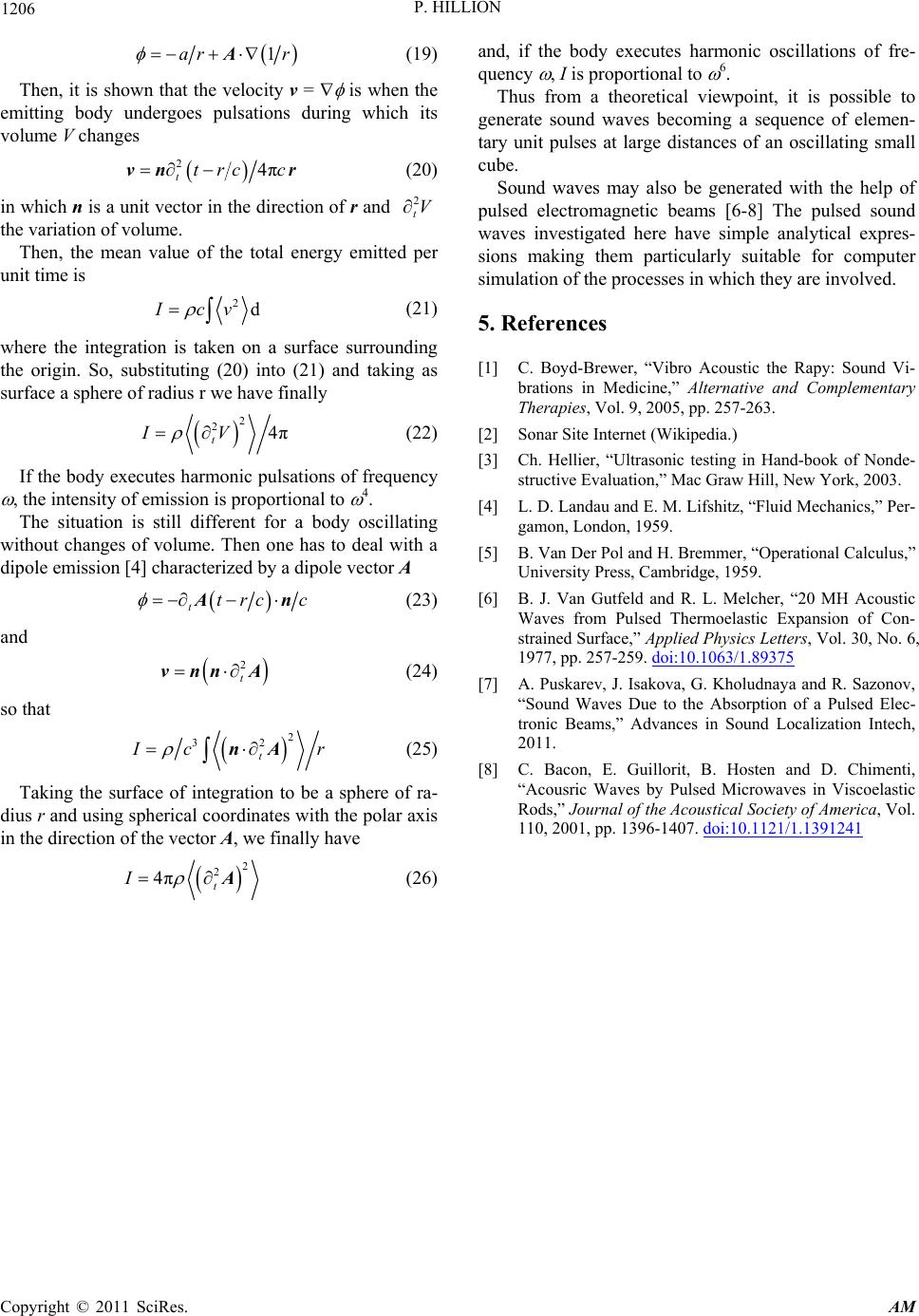
P. HILLION
Copyright © 2011 SciRes. AM
1206
1ar r
A
(19) and, if the body executes harmonic oscillations of fre-
quency
, I is proportional to
6.
Then, it is shown that the velocity v =
is when the
emitting body undergoes pulsations during which its
volume V changes
Thus from a theoretical viewpoint, it is possible to
generate sound waves becoming a sequence of elemen-
tary unit pulses at large distances of an oscillating small
cube.
24π
ttrc c vn r (20)
Sound waves may also be generated with the help of
pulsed electromagnetic beams [6-8] The pulsed sound
waves investigated here have simple analytical expres-
sions making them particularly suitable for computer
simulation of the processes in which they are involved.
in which n is a unit vector in the direction of r and 2
tV
the variation of volume.
Then, the mean value of the total energy emitted per
unit time is
2dIcv
(21) 5. References
where the integration is taken on a surface surrounding
the origin. So, substituting (20) into (21) and taking as
surface a sphere of radius r we have finally
[1] C. Boyd-Brewer, “Vibro Acoustic the Rapy: Sound Vi-
brations in Medicine,” Alternative and Complementary
Therapies, Vol. 9, 2005, pp. 257-263.
2
24π
t
IV
(22) [2] Sonar Site Internet (Wikipedia.)
[3] Ch. Hellier, “Ultrasonic testing in Hand-book of Nonde-
structive Evaluation,” Mac Graw Hill, New York, 2003.
If the body executes harmonic pulsations of frequency
, the intensity of emission is proportional to
4. [4] L. D. Landau and E. M. Lifshitz, “Fluid Mechanics,” Per-
gamon, London, 1959.
The situation is still different for a body oscillating
without changes of volume. Then one has to deal with a
dipole emission [4] characterized by a dipole vector A [5] B. Van Der Pol and H. Bremmer, “Operational Calculus,”
University Press, Cambridge, 1959.
ttrc c
n (23) [6] B. J. Van Gutfeld and R. L. Melcher, “20 MH Acoustic
Waves from Pulsed Thermoelastic Expansion of Con-
strained Surface,” Applied Physics Letters, Vol. 30, No. 6,
1977, pp. 257-259. doi:10.1063/1.89375
and
2
t
vnn A
(24) [7] A. Puskarev, J. Isakova, G. Kholudnaya and R. Sazonov,
“Sound Waves Due to the Absorption of a Pulsed Elec-
tronic Beams,” Advances in Sound Localization Intech,
2011.
so that
2
32
t
c
nA r
(25)
[8] C. Bacon, E. Guillorit, B. Hosten and D. Chimenti,
“Acousric Waves by Pulsed Microwaves in Viscoelastic
Rods,” Journal of the Acoustical Society of America, Vol.
110, 2001, pp. 1396-1407. doi:10.1121/1.1391241
Taking the surface of integration to be a sphere of ra-
dius r and using spherical coordinates with the polar axis
in the direction of the vector A, we finally have
2
2
4πt
I
A (26)